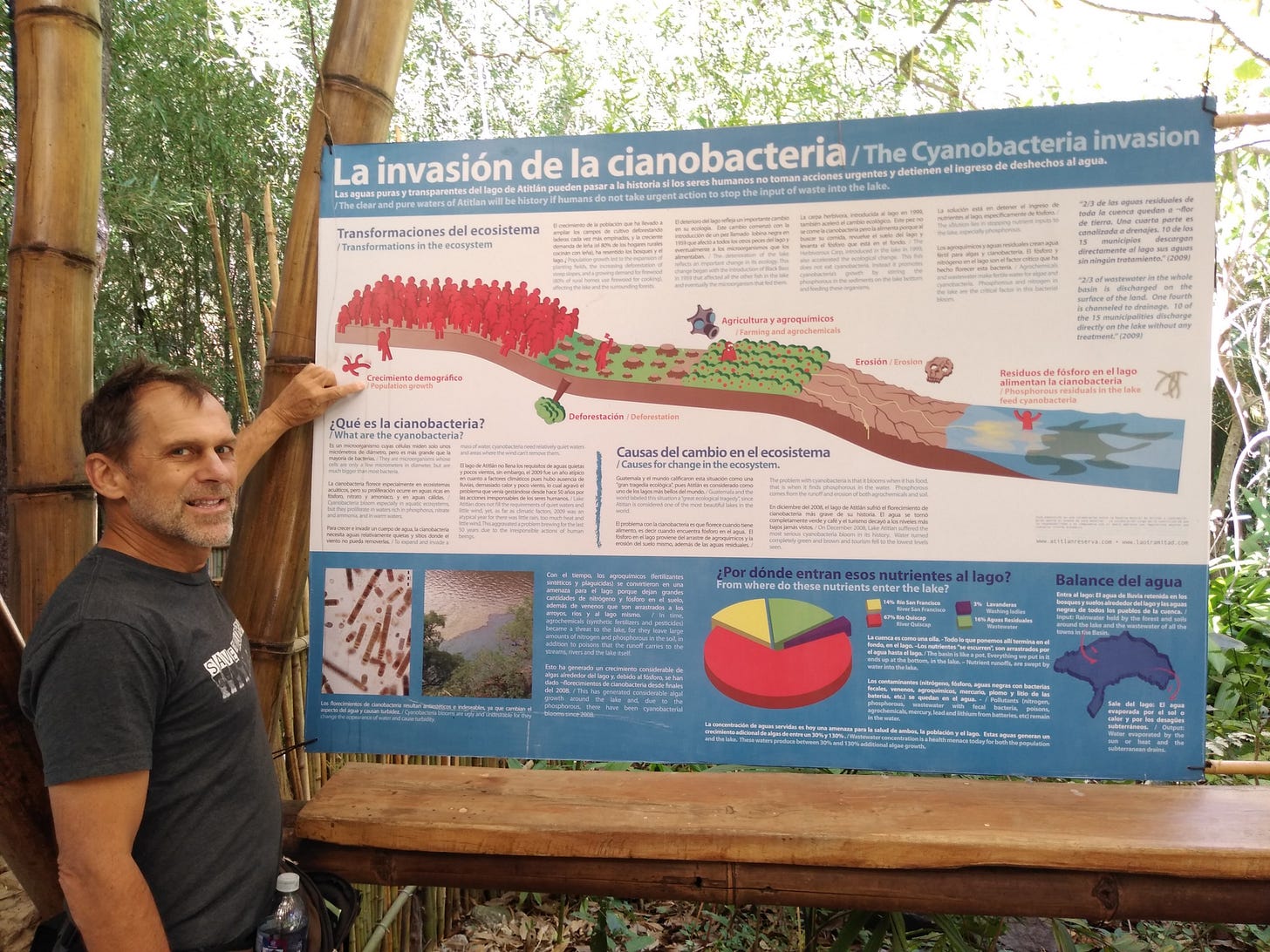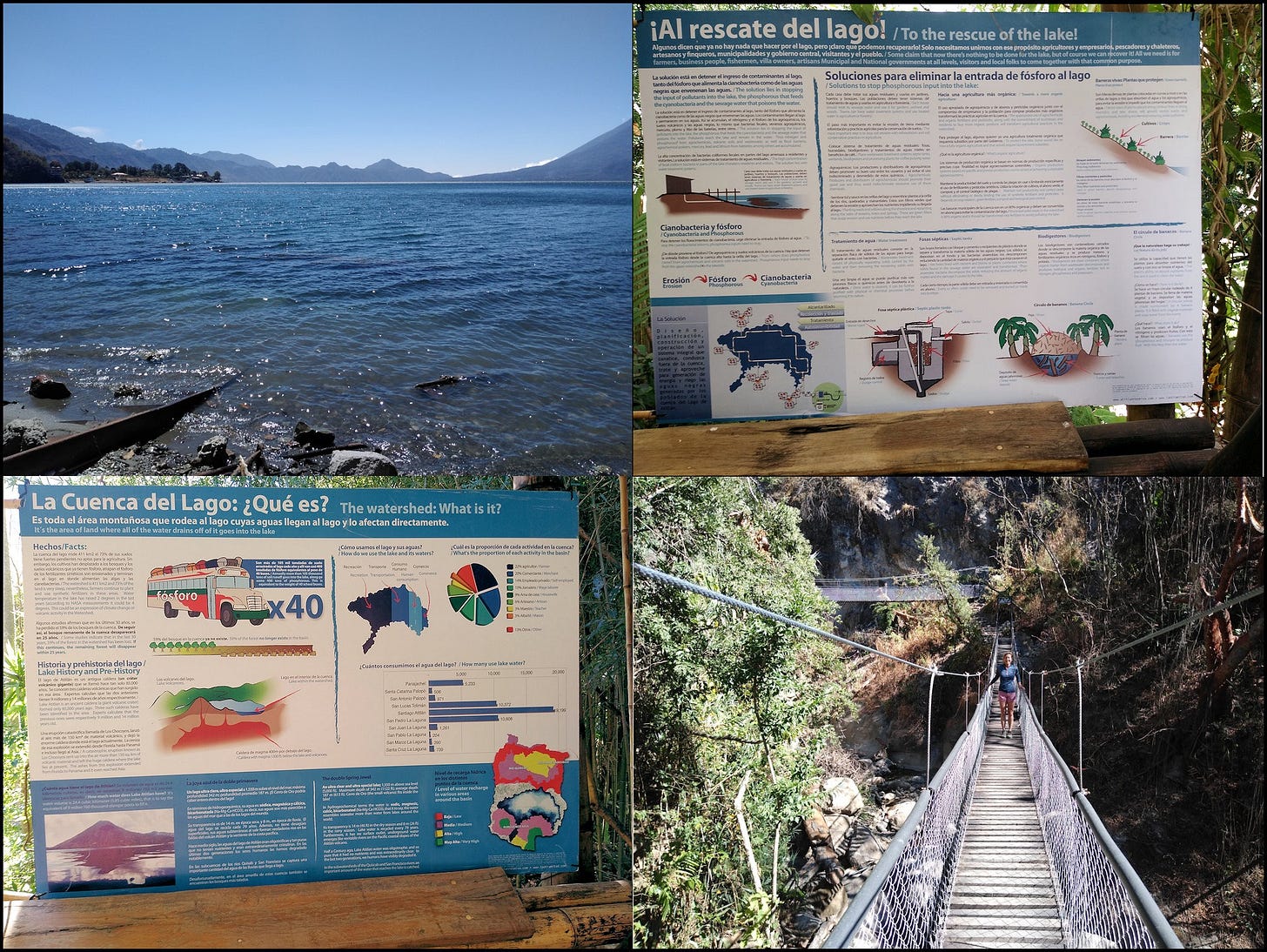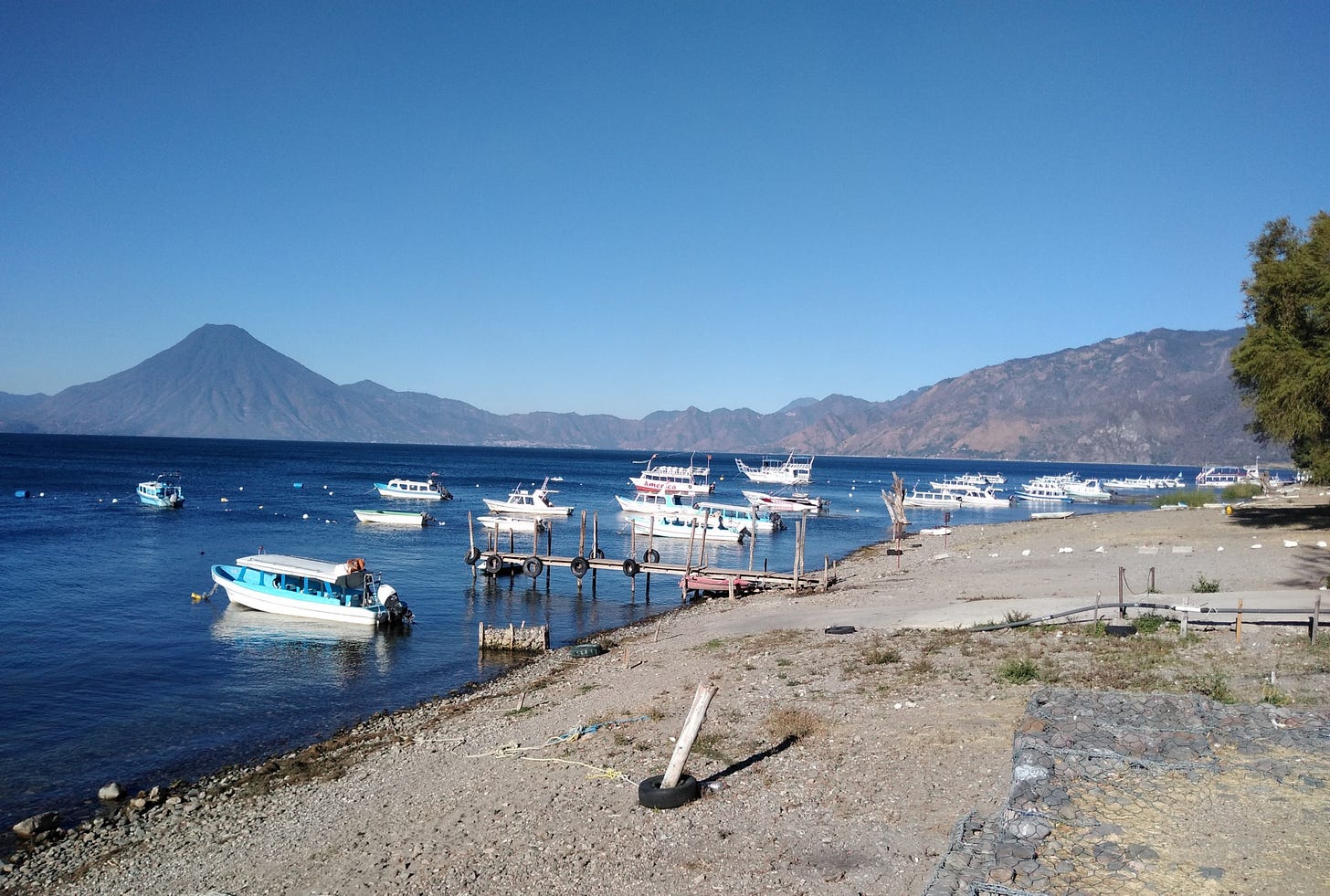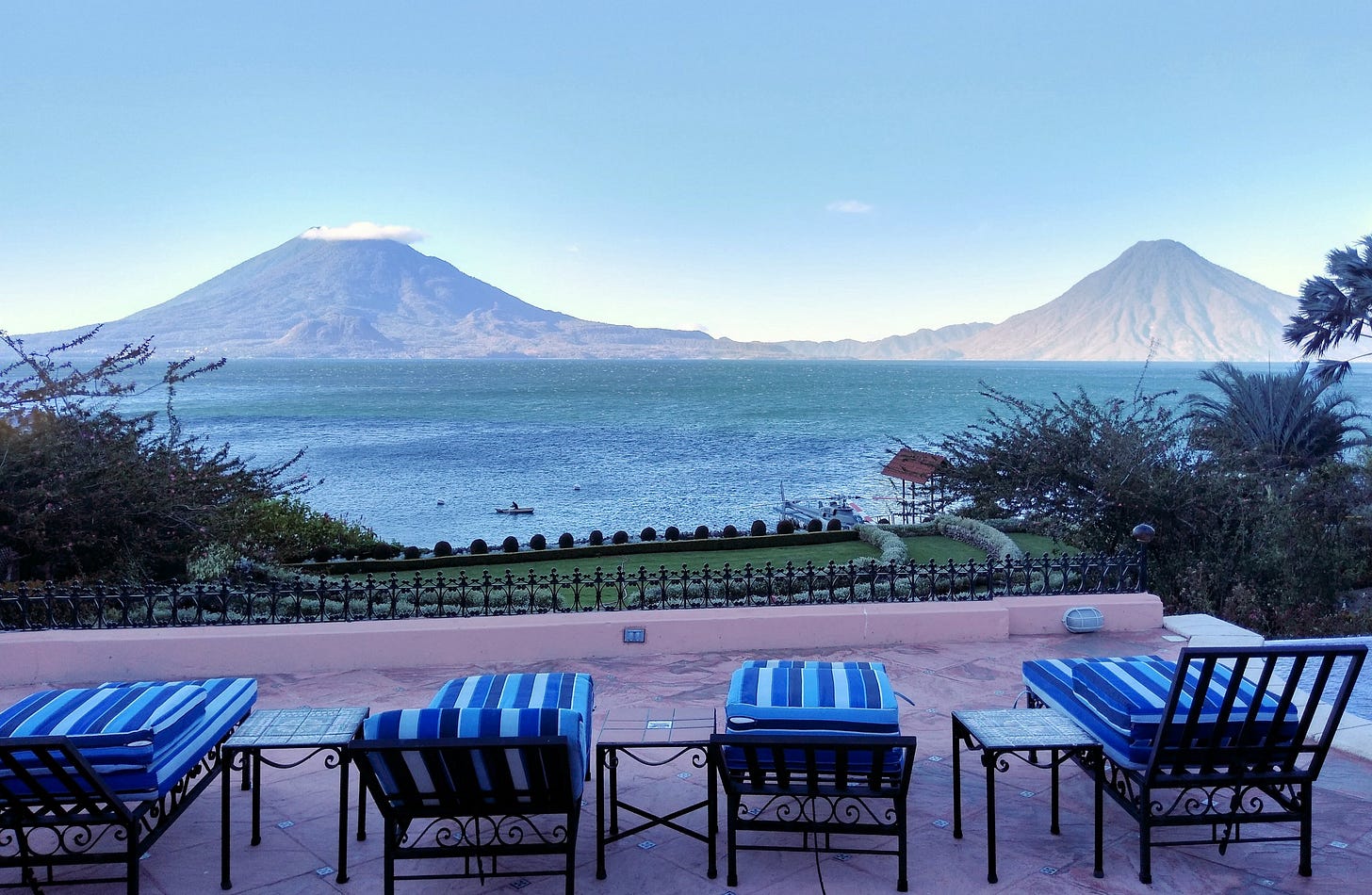Population, Pollution, Pandemic — the Race to Save Lake Atitlan in Guatemala
“Lake Como, it seems to me, touches on the limit of permissibly picturesque, but Atitlán is Como with additional embellishments of several…
“Lake Como, it seems to me, touches on the limit of permissibly picturesque, but Atitlán is Como with additional embellishments of several immense volcanoes. It really is too much of a good thing.” — Aldous Huxley, Beyond the Mexique Bay, 1934

As we drove down Highway 1, we kept getting glimpses of Lake Atitlan in the valley below. The day was partly cloudy, as well as hazy, and we could see the sparkling water in the lake below intermittently sprinkled through the car window. I remember saying “it’s big” — indeed it is a big lake. At 50 square miles of surface area and over 1,000 feet deep, the lake sits at 5,125 feet above sea level ringed by a few amazing volcanoes.

An educational banner about bacterial pollution in the Lake, at the Reserva Natural Atitlan, near Panajachel.
Just before the coronavirus lockdowns, I had the extraordinary opportunity to visit Lake Atitlan in Guatemala. I was there to meet with a local group, Friends of Lake Atitlan (Amigos de Atitlan), to learn all about their work and how I could help them. The lake is under extreme threat from pollution caused by population growth. LOTS of untreated wastewater (human sewage) flows into the lake causing intense bacteria outbreaks that cloud the water, cause algae blooms on the surface, and create horrendous public health problems in the local community. Currently, around 350,000 people live around the lake in 15 towns and cities; that number is expected to double in the next 20–30 years. Most of their wastewater flows untreated into the lake — there are currently 14 wastewater treatment plants, whereas 80 are needed.
Amigos de Atitlan has several programs operating in the watershed including programs to address deforestation, trash collection, education in the schools about watershed health, recycling, and reforestation and revegetation. Most of this work tries to protect the lake and the watershed — because the lake is in a bowl ringed by mountains, everything flows downhill into the lake. Amigos de Atitlan is a fairly large organization with 25 staff and a budget of over U.S. $500,000/year. They operate in several communities around the lake and are active on social media.

Gary Wockner (left) with Jose Toriello (right) in the town of San Juan, overlooking Lake Atitlan.
The President of Amigos de Atitlan is Jose Toriello, an exuberant young man filled with energy and enthusiasm for protecting the watershed and saving the Lake. Jose took us on a tour of the lake to several towns, describing the challenges facing the lake, as well as the history and culture of the people and landscapes in the watershed.

The village of San Juan, Guatemala
The village of San Juan is one of the most famous tourist areas around the lake. It has a thriving arts community and culture, with a never-ending stream of boats shuttling global tourists in and out. Visual arts and tapestry are on display, with local artists happy to talk about their work and how it fits into the cultural history of the region.

The Reserva Natural Atitlan.
Just outside of the town of Panajachel is the Reserva Natural Atitlan. The Reserva’s primary function is an educational area where school children and tourists can learn about the lake and its threats. It’s also a small tourist recreational center with zip lines, hanging bridges, and wildlife viewing (including coatimundi) — all in the forest canopy. We visited Guatemala during the dry season (February), which had less bugs and better views. The downside of visiting in February is that the landscape was dry and brown, and the waterfall in the Reserva was more of a sprinkle. The Reserva educational banners are excellent and pull no punches in describing the population and pollution problems around the lake.

The proposed “Super Collector”.
Amigos de Atitlan and other colleagues have introduced a novel concept for how to address the growing pollution problem in and around the lake, called the “Super Collector”. Promoted on the website AguaLimpiaya.org (“Clean Water Now”), the concept argues for collecting all of the sewage from communities around the lake through an underwater pipe system, and then pumping that water out of the basin to be purified in one large treatment plant. Amigos de Atitlan argues that this is the cheapest and most effective solution to clean up the lake — the concept is estimated to cost around U.S. $89 million, compared to higher costs for building dozens of local treatment plants and other options.
Amigos de Atitlan states that tourism around the lake brings in around U.S. $300 million per year to the Guatemalan economy, making the Super Collector a good investment. Further, and perhaps more importantly, the people in the watershed — especially children — have very high rates of water-borne diseases, especially chronic dysentery and diarrhea, that dramatically impacts health, schooling, and the economy. A clean lake, which is also the source of most of the community’s drinking water, would have a big payoff and be a very positive investment for public health and the local economy.

Atitlan Sunset Lodge. Armand Boissey (top right); Cat Ebeling, my traveling partner (bottom right)
Tourism is a huge part of the economy of Lake Atitlan. While much of the tourism is “budget” appealing to backpackers and young millennial travelers, very nice places are also available at affordable prices. The treasurer for Amigos de Atitlan (and also the President of the local Rotary E Club), Armand Boissy (picture top right), operates an AirBnB/lodge that is perched on the steep shore of the lake near the town of Santa Cruz. The lodge is called the “Atitlan Sunset Lodge” and offers kayaking trips, hiking, and extraordinary vegan meals (and desserts!). Further, the farther away from the towns you get on the lake,the clearer the water is — at Armand’s, we could easily see 20 feet down through near-crystalline water.

The pool at Hotel San Buenaventura de Atitlan.
If budget travel is not your interest, even nice lodges are modestly priced. The Hotel San Buenaventura de Atitlan (pictured above, across the street from the Reserva Natural Atitlan) is stunningly private and gorgeous, and was around $100 per night in the height of the tourist season in February 2020. Restaurants nearby in Panajachel also cater to various levels of prices and quality, with none being super expensive. Kayak rentals and lake tours on boats are readily available, as well as taxi (tuk tuk) services in every community along the lake.

Tourist boats along shore in Panajachel.
Guatemala, as well as Lake Atitlan, faces many challenges to its economy, culture, and people. Much of the economy around the lake is tourism, which took a severe hit during the ongoing coronavirus pandemic. The World Bank estimates that nearly 60% of Guatemalans live in poverty, which is abundantly visible when you travel in the country. Population growth — which threatens Lake Atitlan — is also a national threat in the whole country. It’s difficult to travel in Guatemala, and to talk with locals as well as global tourists, without two subjects coming up: 1) extreme poverty, and 2) the U.S.’ immigration policies that lure so many Guatemalans northward. Both are tied together.
While the area round Lake Atitlan is heavily dependent on tourism, the Guatemalan economy is also heavily dependent on “remittances” — which is money that is sent back to Guatemala from family members who have temporarily or permanently emigrated to the U.S. for work (either legally or illegally). The Bank of Guatemala estimates that remittances now exceed U.S. $10 billion per year.
The Guatemalan government estimates that remittances make up a larger part of Guatemala’s economy than any of its agricultural products. In many ways, the U.S. and Guatemala are joined together, even though the vast landscape of Mexico sits between them. Pew Research estimates that at least 1.4 million Guatemalans live in the U.S., either temporarily or permanently, which is about 10% of the entire population of the country of Guatemala. Many news reports in the U.S. over the last few years, including this one in the Wall Street Journal, indicate that of the tens-of-thousands of Guatemalans who try to emigrate to the U.S. every year, 90% do so to find work to escape extreme poverty.

The deck at Hotel Atitlan.
As our trip ended, we sat in the lounge chairs at Hotel Atitlan near Panajachel as the sun began to set. A fisherman paddled by in a small canoe. While tourism is a huge part of the local economy, most of the local people are poor and also live subsistence lifestyles of farming and fishing. The collision of a global tourist trade, a fast-growing Guatemalan human population, and extreme local poverty offers plenty of challenges, to say the least, for how to save the lake. The coronavirus pandemic has also put a monkey wrench in everything as the tourism shutdown is taking the economy down with it.
Amidst all of that, the increasing pollution of Lake Atitlan raises a question: Whose problem is it, and thus who should fix it?
A narrow view of the problem suggests that it is Guatemala’s problem — they caused it and they must fix it. A more expansive view of the problem suggests that it is the whole world’s problem — in fact during my visit I talked with people from over a dozen countries, many traveling, but also many ex-patriots from the U.S., Canada, and Western Europe. Further, while national borders are often hard and fixed — which I respect — many of the Earth’s beautiful natural landscapes seem to exist outside of the concept of a nation, appealing to our global consciousness of respect and awe for the non-human world.
One person I talked to tied much of the problems in the Americas together. Because the U.S. immigration policies — which allow over a million Guatemalan’s to work in the U.S. and send “remittances” back to Guatemala — cause extraordinary political tension in the U.S., a compromise solution might be found. The person suggested that, “If the U.S. could help us fix the lake and make our country more livable and economically viable, then perhaps there wouldn’t be so much of an immigration problem in the U.S.”

Gary paddling on the lake.
Amigos de Atitlan has now set up “The Atitlan Fund”, which is a 501c3 non-profit organization that can collect money in the U.S. to help save the lake.
Whoever’s problem it is, and whatever the solution, Aldous Huxley had it right, “Lake Atitlan really is too much of a good thing”. We all need to work together to save it.
*****



